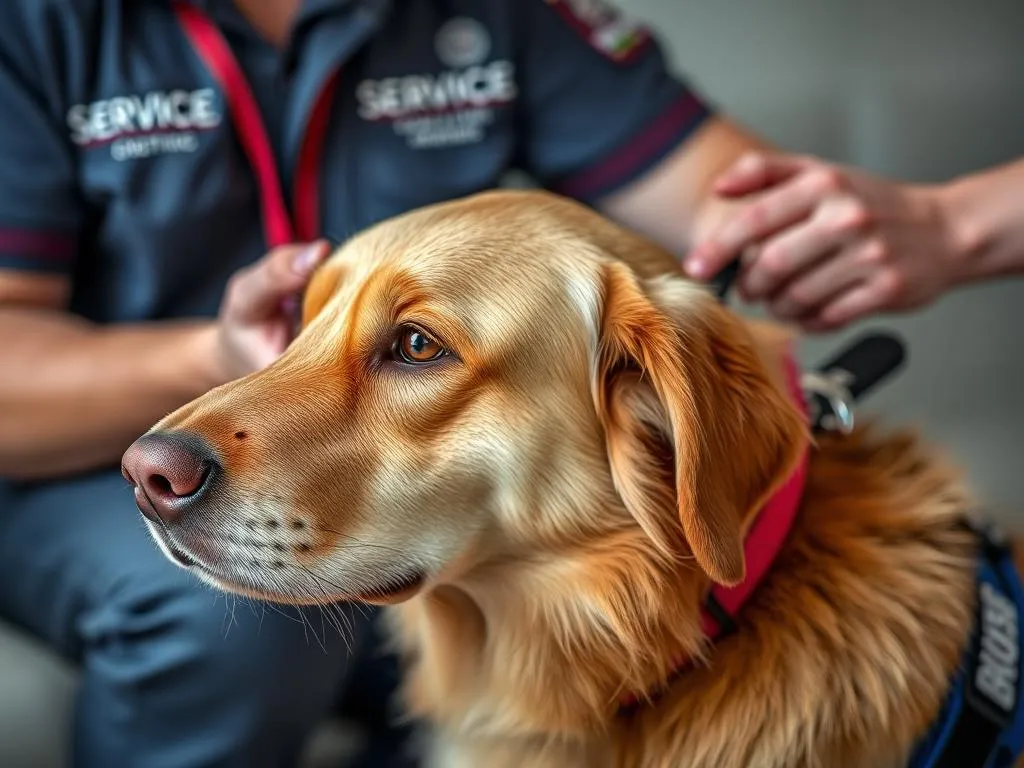
Introduction
Service dogs are specially trained canines that provide assistance to individuals with disabilities, enhancing their quality of life and independence. These remarkable animals are more than just companions; they are vital partners in navigating daily challenges. The process of certifying a service dog can be intricate, involving various steps and requirements to ensure both the dog and handler are prepared for the responsibilities they will face together.
Certification not only validates the training and capabilities of the service dog but also grants the handler certain rights under the law. Throughout this article, we’ll delve into the essential aspects of service dogs, including their legal framework, training requirements, and the steps needed to certify one.
Understanding Service Dogs
What is a Service Dog?
A service dog is specifically trained to perform tasks that assist individuals with disabilities. These can include physical impairments, mental health conditions, or sensory disabilities. Unlike therapy dogs or emotional support animals, which offer comfort and companionship without any specific training for tasks, service dogs are trained to perform tasks directly related to a person’s disability.
Legal Framework
The Americans with Disabilities Act (ADA) establishes the legal groundwork for service dogs in the United States. Under the ADA, service dogs are defined as dogs that are individually trained to perform tasks for people with disabilities. However, it’s important to note that the ADA does not recognize therapy dogs or emotional support animals as service dogs.
When navigating the landscape of service dog certification, it’s crucial to understand both state and federal laws. While the ADA provides general guidelines, some states may have additional regulations regarding the certification and use of service dogs. Misconceptions abound, with many believing that a specific certification or registration is required; however, the ADA does not mandate formal certification for service dogs.
Requirements for Service Dogs
Qualifying Disabilities
Service dogs assist individuals with a variety of disabilities. Here are some examples of conditions that may warrant the use of a service dog:
- Mobility impairments: Service dogs can help individuals with physical disabilities by providing stability, retrieving items, and aiding in navigation.
- Hearing impairments: These dogs alert their handlers to important sounds, such as alarms or a knock at the door.
- Vision impairments: Guide dogs are trained to help individuals navigate their environment safely.
- Seizure disorders: Some service dogs can alert their handlers to an impending seizure or provide support during one.
- Mental health conditions: Dogs can be trained to assist individuals with PTSD, anxiety, or depression by providing calming pressure or alerting to triggers.
Characteristics of Service Dogs
Not all dogs are suited to become service dogs. A good service dog must possess specific traits, including:
- Temperament: The dog should be calm, friendly, and well-socialized.
- Behavior: A service dog must be obedient and responsive to commands.
- Health: The dog should be in good health and capable of performing its tasks without hindrance.
Proper training and socialization are essential in cultivating these traits, ensuring the dog is well-prepared for public interactions and task performance.
Training Your Service Dog
Basic Training
Before a dog can become a certified service dog, it must learn essential commands. Some basic commands include:
- Sit
- Stay
- Come
- Down
- Leave it
Reinforcing these commands through positive reinforcement techniques, such as treats and praise, will help establish a solid foundation for further training.
Specialized Training
Once the basic commands are mastered, the dog can undergo specialized training tailored to the handler’s specific needs. This may include tasks like retrieving objects, providing balance support, or performing a medical alert. Many professional training programs can assist in this process, providing guidance on how to develop these specialized skills.
Public Access Training
Public access training is a critical component for any service dog. This training ensures that the dog can behave appropriately in various environments, such as restaurants, grocery stores, and public transportation. Guidelines typically include:
- Remaining calm in crowded spaces
- Ignoring distractions
- Responding reliably to commands in public settings
Successful completion of public access training is essential for the dog’s certification and the handler’s confidence when navigating the world together.
Certification Process
Understanding Certification
It’s essential to clarify what certification means in the context of service dogs. Certification does not imply any official recognition or government endorsement. Rather, it signifies that the dog has completed training and is capable of performing tasks to assist its handler.
Documentation is a critical aspect of service dog certification. While the ADA does not require a specific certification, having a letter from a licensed mental health professional or medical doctor can help clarify the necessity of the service dog for public access situations.
Steps to Certify a Service Dog
The process of certifying a service dog can be broken down into several key steps:
- Assess your dog’s suitability: Evaluate your dog’s temperament and behavior to determine if it has the potential to be a service dog.
- Train your dog for specific tasks: Engage in obedience training and specialized task training tailored to your needs.
- Choose a certification organization: Research and select a reputable organization that aligns with your goals.
- Complete necessary paperwork: Gather any documentation required by the chosen organization.
- Attend evaluations or tests: Many organizations will require an evaluation to assess the dog’s training and behavior.
Choosing a Certification Organization
Selecting the right certification organization is crucial. Here are some factors to consider:
- Reputation: Research the organization’s history and success rate.
- Training methods: Ensure their training philosophy aligns with positive reinforcement techniques.
- Support: Look for organizations that offer ongoing support and resources for service dog teams.
Legal Rights and Responsibilities
Rights of Service Dog Handlers
Handlers of service dogs have specific rights under the ADA, including:
- The right to access public spaces with their service dog.
- Protection from discrimination based on their disability.
It’s essential to be aware of these rights to advocate effectively for yourself and your service dog.
Responsibilities of Service Dog Handlers
With rights come responsibilities. Handlers must ensure that their service dogs are well-cared for and properly trained. This includes:
- Maintaining the dog’s health and hygiene.
- Ensuring the dog is well-behaved in public and does not cause disturbances.
- Respecting the space of others and preventing the dog from engaging in unwanted behaviors.
Understanding and adhering to these responsibilities is vital for fostering a positive experience for both the handler and the community.
Frequently Asked Questions (FAQs)
-
Do I need to register my service dog?
No, there is no legal requirement for registration under the ADA. However, having documentation can be helpful in certain situations. -
Can any dog be a service dog?
Not all dogs have the temperament or traits required for service work. It’s essential to assess the individual dog’s suitability. -
What tasks can a service dog perform?
Service dogs can perform many tasks, including guiding individuals with vision impairments, alerting to sounds for those who are hearing impaired, and providing support during medical emergencies. -
Can I train my own service dog?
Yes, individuals can train their own service dogs, but it’s essential to follow proper training techniques and ensure the dog can perform necessary tasks reliably. -
What can I do if I encounter problems with service dog access?
Familiarize yourself with your rights under the ADA and be prepared to educate others if misunderstandings arise.
Conclusion
Certifying a service dog is a crucial step in ensuring that both the handler and the dog are equipped to face the challenges of daily life together. Understanding the requirements, training processes, and legal rights involved in this journey is vital for success. By following the outlined steps and remaining committed to the training and welfare of your service dog, you can create a powerful partnership that enhances your independence and quality of life.









